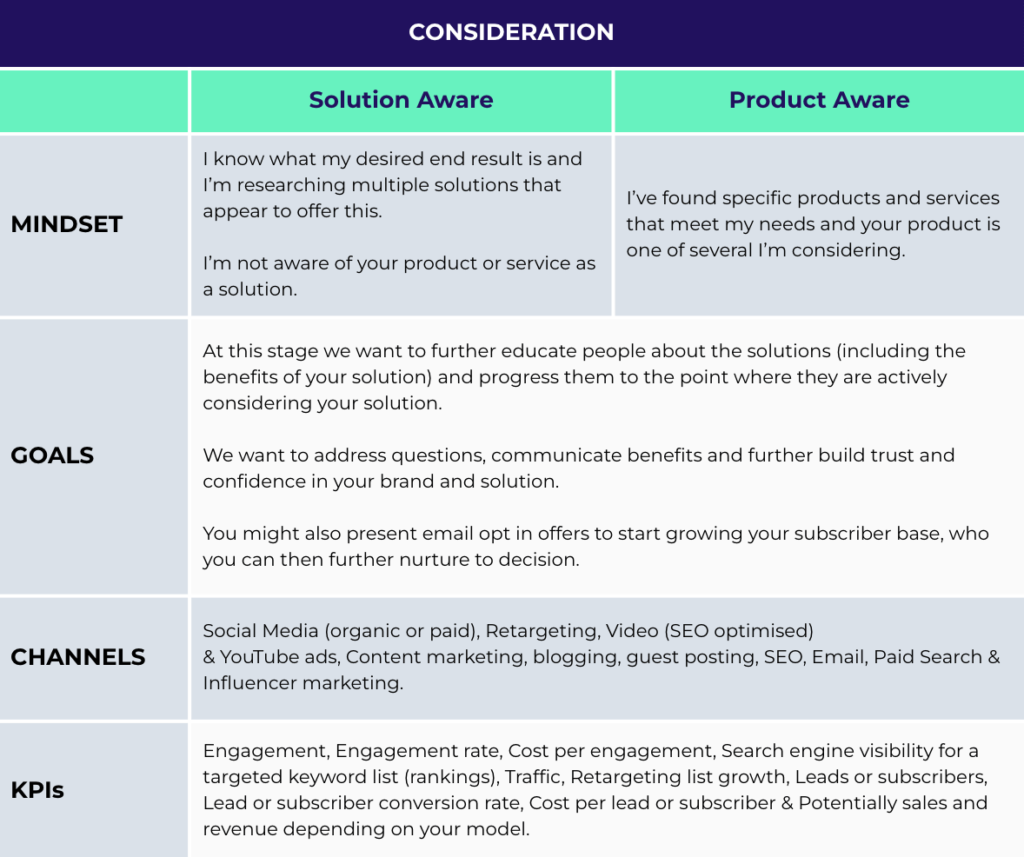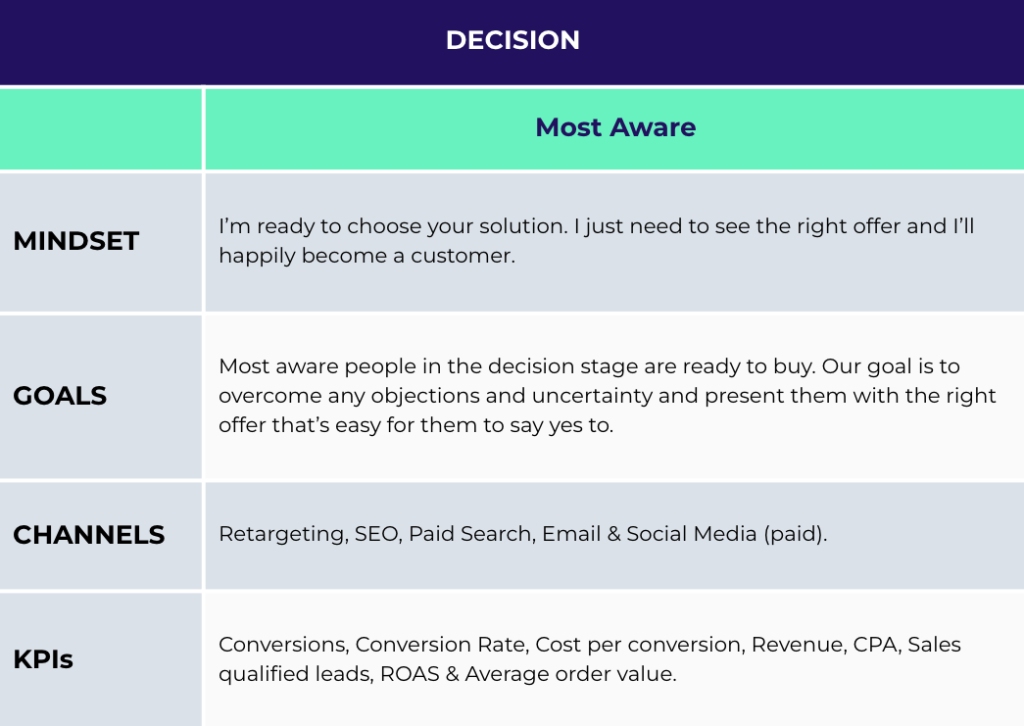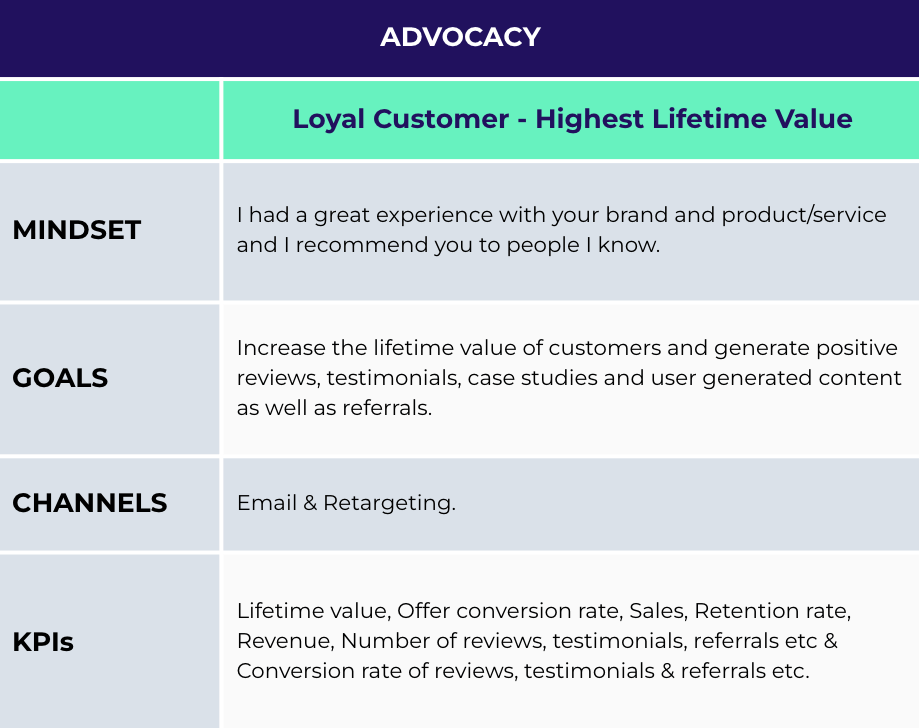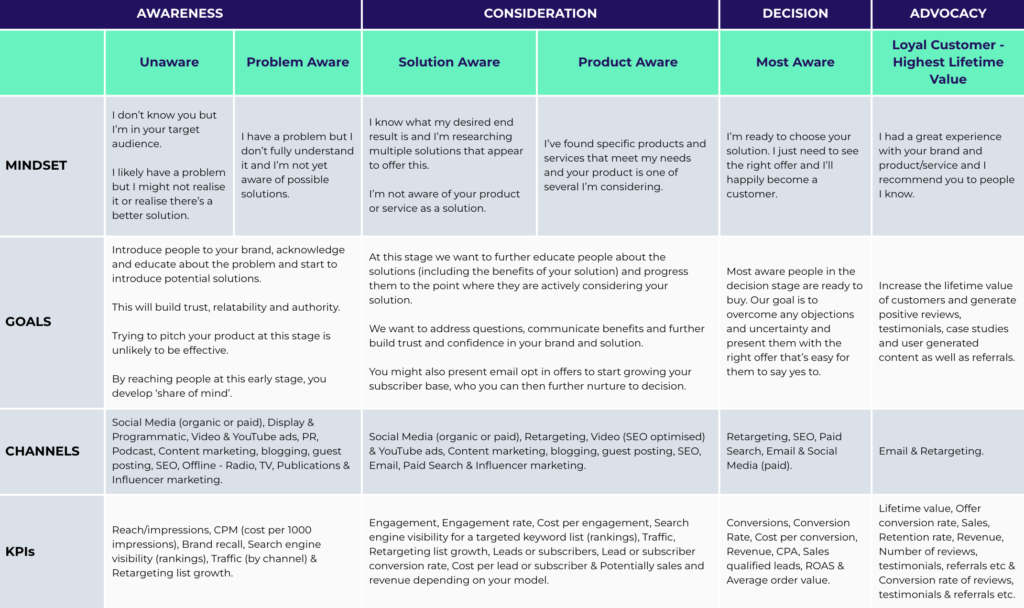Key Timestamps:
- Overview (0:51)
- Stages 1 & 2 Unaware and Problem Aware (1:13)
- Problem Aware (2:59)
- Stages 3 & 4 Solution Aware and Product Aware (6:34)
- Example Case Study (8:42)
- Stage 5 Most Aware (13:53)
- Bonus Stage (16:06)
- Recap and Close (18:04)
Video Script
I think most of you know a thing or two about creating awareness of your brand, products or services among your target market. But you might not have heard of the 5 stages of awareness.
So in this video, we’re going to walk through each of the 5 stages of awareness.
For each stage, I’ll give an overview of what it is and the mindset of the people in this stage. I’ll then provide a recommended approach to marketing communications so you can effectively reach the right people with the right message at the right time and move them from unaware to customer.
So for each stage we’re going to look at:
- What it is and the mindset of people in this stage
- How to meet them where they and effectively communicate with them
- Potential channels you might want to use as part of your digital marketing strategy
- Example KPIs to measure what matters
To help make all this clear, I’ll also walk through an example scenario of how someone moves through each of the 5 stages to become a customer.
Stages 1 & 2: Unaware & Problem Aware

Overview
Even if the product is simple with a low price point and a very short buying journey, people still need to be aware of the problem, your brand and your offer in order to become a customer.
That’s why people will always start their journey in either the unaware or problem aware stage.
These are the earliest stages and therefore the most challenging from a marketing perspective… but this audience will also be the largest and probably has the least number of competitors fighting for their attention.
—
The mindset of people in the unaware stage
Unaware people might meet your target audience criteria but they don’t know your brand or what you sell.
What’s more, they might not even be aware of the problem, or at least that a better solution exists to the problem.
—
So how should you approach marketing communications with unaware prospects?
Present a problem that you believe they will care enough about so they want to learn more.
Your messaging at this stage, calls out the prospects interested in the problem, who self identify by engaging with your content or ad.
By effectively reaching them, capturing their attention and educating them about the problem, you will start to make them problem aware.
If you do this effectively, many will be eager to learn more about the problem.
Important: The less aware a person is, and the more complex or expensive your product, the more education you have to provide before they will be open to a direct response offer.
—
What about people who are already problem aware? How should you communicate to people at this stage of the customer journey?
The key here is to have a thorough understanding of 3 things:
- Knowing your target market
- Having an appreciation of the triggers that might have happened in their life to cause them to go from unaware to problem aware
- Having a good understanding of the problems they face and all the different questions they may have relating to their problem.
When someone is problem aware, they know that they have a problem but they don’t know, like or trust you.
At this stage, you need to continue to educate them about the problem. This fills their knowledge gap while positioning your brand as an authority on the topic which builds like and trust.
Feeling like they know enough about their problem and having built a certain level of trust for your brand, they will now be receptive to you introducing solutions.
This will help them to progress to the next stage of the customer journey. Solution aware.
—
Let’s look at an example to help make things clear:
A person might be out of shape with an unhealthy lifestyle, but be unaware that it’s a problem.
At a routine medical, the doctor advised them of the serious health risk if they did not change their unhealthy habits. They just went from unaware to problem aware.
Just like in this example, think about the triggers in people’s lives that might cause them to move from unaware to problem aware.
If you’re going after unaware prospects, your marketing will need to be the trigger.
—
OK so what channels might be good to use to reach people in the unaware and problem aware stage
Unaware prospects are not actively searching for information and don’t know your brand, so you need to find out where they hang out online and if your offer is compelling and interesting enough, they just might click.
For a cold, unaware audience think:
- Social media
- Display and programmatic
- Video and YouTube ads
- Influencer and brand collaborations
- Native ads
- Or even traditional offline channels.
Now… Problem aware prospects ARE searching for information.
Google and YouTube are obvious choices that most people turn to, so think:
- Keyword research and SEO optimisation
- Content marketing, blogging and guest posting
- SEO optimised videos and YouTube ads
- Social media (which can be used at almost any stage)
Lower intent channels such as display, programmatic and native ads will continue to drive low cost traffic to your site to help drive awareness and grow retargeting lists.
You might want to start thinking outside the box a little too.
You’ll likely find your target market discussing their problems in relevant forums, Q&A sites like Quora and in niche social media groups.
Remember: No target market is the same and some will require significantly more nurturing and education than others before they are ready to move to the next stage of awareness.
—
Metrics to measure
We identified that people in the unaware and problem aware stages are unlikely to be receptive to direct response offers… but you still need to know how well your campaigns are performing.
Metrics that you might want to measure at this stage are:
- Reach/impressions
- CPM (cost per 1000 impressions)
- Brand recall
- Search engine visibility (rankings)
- Traffic (by channel)
- Retargeting list growth (more on retargeting in just a moment)
Stages 3 & 4: Solution Aware & Product Aware

Overview
When you feel well informed about your problem, the next logical step is you want to fix it.
People in the solution aware stage are starting to form a clear desired end result of what they want from a solution… and are open to products and services that might be able to deliver this.
—
So how should you approach marketing communications with people in the solution aware stage?
Having filled their information requirements about the problem, they know solutions exist and are now looking to be more informed about the solutions.
So first meet them where they are and identify with the problem. This gets their attention so you can go on to educate them further about solutions, all the while building more trust and authority, before you introduce your offer.
As part of this stage, they will be researching and evaluating offers and becoming product aware. This is so that they feel confident enough to eventually make an informed buying decision when they are ready to become a customer.
When you’re educating them about the solution, make sure to focus on the benefits of your solution so that when you do present your offer, they will be primed to take action.
Tip: Make sure you know the desired end result of each of your target audience personas and speak to this vision with your content, offers and marketing communications.
Nurturing the desire for the end result will improve your emotional connection and their motivation to act.
Depending on your buying journey, your ‘offer’ that you introduce at this stage might be to entice people on to your email list as the next logical step.
Once on your email list, you can continue to provide them with content around the benefits of your solution and help them to understand why your solution is the best one for their needs.
This will increase their product awareness while helping to move them to the decision stage where they are ready to buy your product.
—
Let’s revisit our example again in detail to help make things clear:
After a doctor advised our example person in a routine medical of the risks of their unhealthy habits, they became problem aware and instantly started searching Google for all the questions and concerns they had around the implications of an unhealthy lifestyle.
This included questions around bad diets, lack of exercise and how carrying too much weight can affect your health. They were also clicking anything on the topic that caught their attention as they browsed the web and social media.
After performing a search in Google, they clicked on your blog post that appeared in the search results.
They received value from the information they read and because they visited your website to read the post, they were now on your retargeting list.
Later, while scrolling through their Facebook newsfeed, they were presented with another piece of content from you as a result of your retargeting campaign.
This time your content was a great guide to exercising aimed at someone just starting out who didn’t want or have the confidence to join a gym.
Our example person has already been reading about different ways to exercise and after having looked at gyms and personal trainers, they are now leaning more towards doing their own thing from home. At least initially.
Your content connects with their problem and meets them where they are and your fantastic breakdown of the home exercise solutions and the associated benefits, further confirms in their mind that a home solution is the right way forward for them.
You just happen to sell online diet, exercise and consultancy packages.
People who are visiting the website or engaging on social media with solution focused content can be presented with offers. In this example they might not be ready to sign up to your package so you might want to present them with an offer to turn them into a subscriber.
After having read your home exercise guide, you might present them with an offer of a 1 month free trial of your subscription package. If that proves to be still too strong an offer, you might want to repackage 1 month’s worth of the most popular home exercise routines from your program and offer it as a digital download in exchange for them becoming a subscriber.
You’d present them with this offer via calls to action in the content and via retargeting.
Now on your email list and loving your home exercise routines, our example person has a lot of trust in your brand and associates you with value.
You continue to communicate with them via email, search and social to further educate them as to the benefits of your service.
You also start to show them some of the results that other people similar to them have experienced as a result of your program.
So our example person has gone from unaware to problem aware to solution aware and is now very product aware. They are thinking more and more that your solution is exactly what they need to help them achieve the desired end result.
—
What channels might be good to use to reach people in the solution and product aware stage?
Just as people in the problem aware stage have lots of questions about the problem, people in the solution aware stage have lots of questions around potential solutions and are researching products and services.
At the consideration stage, you should have in your audience a mixture of people who have visited your website or engaged on social media and people who are engaging with your brand for the first time.
At the solution aware stage it’s time to review keywords and double down on:
- SEO optimisation
- Content marketing, blogging and guest posting
- SEO optimised videos and YouTube ads
- Social media
You’ll probably find your target market discussing solutions in the same or similar places to the people discussing problems. Relevant forums, Q&A sites like Quora and in niche social media groups.
For the audience segment that has engaged with your brand, you can use:
- Retargeting across Google and social media sites to present either more content and/or offers
- For people on your email list, you can use email and customer match targeting to reach them across search and social
- You might also want to use the data Google and the main social networks hold about your email list to create ‘similar/lookalike audiences’ to include as part of your awareness campaigns
Remember: No target market is the same and even at the solution and product aware stages, you might still have a significant amount of work to do to keep this audience engaged, slowly nurturing them towards decision.
—
Metrics to measure the success of your campaigns at the solution and product aware stages
People in the solution aware stage will start to be open to offers in addition to researching.
So metrics that you might want to measure at this stage are:
- Engagement
- Engagement rate
- Cost per engagement
- Search engine visibility for a targeted keyword list (rankings)
- Traffic
- Retargeting list growth
- Leads or subscribers
- Lead or subscriber conversion rate
- Cost per lead or subscriber
- Potentially sales and revenue depending on your model
Stage 5: Decision

Congratulations! You’ve done a fantastic job in either creating a desirable product, growing a strong brand or nurturing people from the awareness stage to the point of decision… or maybe you’ve achieved all of those things.
Now you just need present the right offer to make them take action and become a customer.
Your messaging here will probably be focused around a call to action and a landing page and your value proposition will be one of the most important elements in capturing their attention so test different variations to find the highest converting offer.
Your landing page should overcome any known objections, and reduce anxiety, fears, doubts and uncertainty and offering a strong guarantee can really help with this.
If you can factor in any genuine urgency as to why they should take action right now, then this can help to increase the number of people who do.
Back up any claims you make with evidence and include social proof such as testimonials, reviews and if you’ve been featured in known publications where appropriate.
Finally, get out of their way and make it as easy as possible for them to become a customer.
Reduce friction anywhere and everywhere you can. So for example: don’t make them create an account before they can buy and is that really long form spread over 3 pages really needed?
—
Example channels to reach decision-making prospects:
- Retargeting
- SEO
- Paid Search
- Social Media (paid)
Conversion Optimisation can and should be used throughout all 5 stages of awareness, but at this stage, the closest point to conversion, it can make a real impact on the bottom line if the right opportunity exists.
—
Example metrics to measure at the decision-making stage
- Conversions
- Conversion Rate
- Cost per conversion
- Revenue
- CPA
- Sales qualified leads
- ROAS
- Average order value
—
Bonus Stage: Advocacy

You have a high converting customer journey and your customer base is growing… along with the number of happy customers who love your brand.
This stage of the customer journey is a great opportunity to increase the lifetime value of your customers and generate positive reviews, testimonials, case studies and social proof from user-generated content.
Customers in the advocacy stage are also your best prospects to leverage for referrals.
For generating positive reviews and testimonials, think about when, where and how you might want to ask for this. Same with referrals and if you can offer some form of incentive then this will probably entice more people to take the action you want them to.
If you require user-generated content to show new prospects at earlier stages of the customer journey that there are a lot of people just like them loving the product, then consider running a user-generated content competition.
People in the advocacy stage are your best customers so highly likely to be interested in new product offers, repeat purchases of existing products, product upgrades or simply products and services that you think these people will be interested in.
Presenting them with targeted or occasional offers should see an increase in your customer lifetime value.
—
Channels to use at the advocacy stage:
- Retargeting
—
Metrics you might want to measure at the advocacy stage:
- Lifetime value
- Offer conversion rate
- Sales
- Retention rate
- Revenue
- Number of reviews, testimonials, referrals etc
- Conversion rate of reviews, testimonials, referrals etc
—
So to recap, we’ve looked at:
- How your target audience starts off in the unaware stage and the journey they take to decision and advocacy
- How to approach marketing communications at each of these stages
- The right stage to present them with direct response offers
- Which channels to use at each stage to effectively reach the audience
- What metrics to measure to analyse the success of your digital marketing efforts
That wraps up today’s video so hopefully you found the content useful and practical with takeaways you can start testing immediately.
As always we’re open to feedback and suggestions so if there is anything you’d like to see us cover in a future video, please feel free to let us know.
Thanks for watching and enjoy your day.


